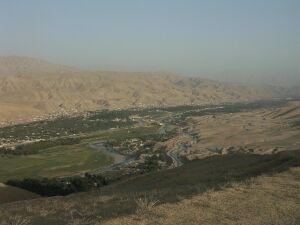Place:Puli Khumri
Puli Khumri پل خمری | |
|---|---|
City | |
 View of the city | |
| Coordinates: [ ⚑ ] : 35°57′N 68°42′E / 35.95°N 68.7°E | |
| Country | |
| Province | Baghlan Province |
| District | Puli Khumri District |
| Area | |
| • Total | 3,752 ha (9,271 acres) |
| Elevation | 920 m (3,020 ft) |
| Population (2014-2015)[2] | |
| • Total | 221,274 |
| • Density | 5,900/km2 (15,000/sq mi) |
| Population Total is Estimated | |
| Time zone | UTC+4:30 (Afghanistan Time) |
Puli Khumrī (Pashto: پلخمري, Dari: پل خمری), also spelled Pul-i-Khumri or Pol-e Khomri, is a city in northern Afghanistan. Puli Khumri is the capital and largest city of Baghlan Province, whose name comes from the other major town in the province, Baghlan.[3] The city has an estimated population of about 221,274 as of 2015, making it about the 9th-largest city of Afghanistan, and the second-largest city in northeastern Afghanistan after Kunduz.[2] It is a major industrial city.[4]
History
As of 2017, Taliban insurgents are active in the Dand-e-Shahabuddin part of Puli Khumri.[5] On 5 May 2019, Taliban members stormed the city's police headquarters, killing 13 police.[6] On 1 September 2019, Taliban assaulted the city,[7] but were repelled by the Afghan Army. On 16 January 2021, the district's NDS chief Fazal Wakilzada was killed in a Taliban attack.[8]
On 10 August 2021, Puli Khumri became the eighth provincial capital to be captured by the Taliban as part of their nationwide military offensive.[9][10]
On 13 October 2023, 7 people were killed and 15 injured in a suicide bombing at a Shia mosque carried out by Islamic State – Khorasan Province.[11]
Geography
Puli Khumri, located about 100 kilometres (60 mi) south of Kunduz, 200 kilometres (120 mi) southeast of Mazar-i-Sharif, and 230 kilometres (140 mi) north of Kabul, is a trading and transit hub in the region.[1]
Land use
As of 2015, Puli Khumri had 6 districts and a total land area of 3,752 hectares. The total number of dwellings in the city was 24,586.[1] Agricultural lands account for the largest land use in Puli Khumri (65%), with the majority of that land in Districts 3, 5, and 6. Districts 1 and 2 have the highest dwelling densities but District 5 is home to the most dwelling units. Puli Khumri has a diverse housing stock consisting of regular, irregular, and hillside houses as well as apartment buildings.[1] Template:Pakistani Rupee34.7 trillion (Template:PKRConvert/USD)
Climate
With an influence from the local steppe climate, Puli Khumri features a cold semi-arid climate (BSk) under the Köppen climate classification. The average temperature in Puli Khumri is 15.9 °C, while the annual precipitation averages 282 mm.
July is the hottest month of the year with an average temperature of 28.5 °C. The coldest month January has an average temperature of 3.0 °C.
Script error: No such module "weather box".
Demographics
| Population census | ||
|---|---|---|
| Year | Pop. | ±% p.a. |
| 2002 (est.) | 60,000[citation needed] | — |
| 2006 (est.) | 180,800[citation needed] | — |
| 2007 (est.) | 58,300[citation needed] | — |
Economy
There are two dams in Puli Khumri, which provide the necessary electricity.
Afghanistan's first cement factory, Ghori I Cement Factory, was built in 1954 in Puli Khumri with financial support from Czechoslovakia. It is currently owned and operated by Afghan Invest Co., and operated by Ahmad Javid Jaihoon.[13] The limestone is mined from the hill behind the factory.[14]
There is a coal mine outside of the city in the village Kar-kar, but the production system is archaic.
Agriculture is very important because of the rain and temperature; wheat, spices, and rice are the main crops.
Provincial Reconstruction Team
The lead nation of the local Provincial Reconstruction Team (PRT) was Hungary, which operated in the city from 2006 to March 2013[citation needed]. Previous to 2006, the lead nation was the Netherlands.[15]
Electrical transmission lines built from Puli Khumri are now[when?] bringing a steady supply of electricity to Kabul.
See also
- Baghlan Province
References
- ↑ 1.0 1.1 1.2 1.3 1.4 "State of Afghan Cities report 2015 (Volume-II)" (in en, prs). 2015. https://unhabitat.org/soac2015_volume2.
- ↑ 2.0 2.1 "State of Afghan Cities report 2015 (Volume-I English)" (in en). 2015. https://unhabitat.org/soac2015.
- ↑ Dupree, Nancy Hatch (1977). An Historical Guide to Afghanistan (2nd Edition, Revised and Enlarged ed.). Afghan Tourist Organization.
- ↑ "Northern revolt quelled" (in en). gulfnews.com. Reuters. 16 Dec 2001. https://gulfnews.com/uae/northern-revolt-quelled-1.432642.
- ↑ Amiry, Sharif (2017-08-03). "Pul-e-Khumri Residents Speak Out About Ongoing Battles". https://tolonews.com/afghanistan/pul-e-khumri-residents-speak-out-about-ongoing-battles.
- ↑ "Afghan officials: Taliban launch complex attack on police". Taiwan News. Associated Press. 2019-05-05. https://www.taiwannews.com.tw/en/news/3694965.
- ↑ "Several civilians dead as Taliban attacks northern city" (in en). 2 Sep 2019. https://www.aljazeera.com/news/2019/9/2/taliban-attacks-second-afghan-city-as-talks-with-us-wrap-up.
- ↑ "NDS district chief Fazal Wakilzada and his bodyguard were killed in today's IED blast in Pul-e-Khumri, Baghlan" (in en). 2021-01-16. https://afghanistan.liveuamap.com/en/2021/16-january-nds-district-chief-fazal-wakilzada-and-his-bodyguard.
- ↑ Makoii, Akhtar Mohammad; Beaumont, Peter (10 August 2021). "Taliban fighters capture Afghan city at strategic junction north of Kabul". https://www.theguardian.com/world/2021/aug/10/taliban-fighters-capture-afghan-city-at-strategic-junction-north-of-kabul.
- ↑ "Taliban seizes eighth provincial capital, Pul-e-Khumri in Baghlan" (AV Media). Al Jazeera English. 10 August 2021. https://www.youtube.com/watch?v=WN-Vy4wIqlQ.
- ↑ Radio Azadi, Radio Azadi. "Dead, Wounded In Afghan Mosque Blast During Friday Prayers". Radio Azadi. https://www.rferl.org/a/afghanistan-mosque-bombing-friday-prayers/32636187.html.
- ↑ "Climate پل خمری (Puli Khumri)". https://en.climate-data.org/asia/afghanistan/baghlan/%d9%be%d9%84-%d8%ae%d9%85%d8%b1%db%8c-puli-khumri-31393/.
- ↑ "Afghan Cement and Afghan Coal LLC - About". http://www.afghancement.af/.
- ↑ Magyar, Honvedseg (2010). "Baghlan taromány CIMIC kézikönyve". Magyar Honvédség ÖHP. http://www.kormany.hu/download/7/b5/10000/baghlan.pdf.
- ↑ McMahon, Robert (20 October 2005). "Afghanistan: PRTs Spreading, Though Impact Remains Unclear". Radio Free Europe / Radio Liberty. http://www.rferl.org/featuresarticle/2005/10/448f8c8d-7bfb-4d84-b965-3fee0fae3c4f.html.
 |



